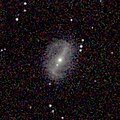NGC 6217
NGC 6217| NGC 6217 | |
|---|---|
 허블우주망원경이 촬영한 NGC 6217 | |
| 관측 데이터(J2000 epoch) | |
| 별자리 | 우르사 마이너 |
| 우측 상승 | 16h 32m 39.217s[1] |
| 탈위임 | +78° 11′ 53.56″[1] |
| 레드시프트 | 0.004543 ± 0.000013[2] |
| 헬리오 방사 속도 | 1368km[3]/s |
| 거리 | 67.2 Mly(20.6 Mpc)[3] |
| 겉보기 크기 (V) | 11.2[4] |
| 특성. | |
| 유형 | (R)SB(rs)bc[5] |
| 겉보기 크기 (V) | 55,000광년 |
| 기타 지정 | |
| ARP 185, UGC 10470[2][6] | |
NGC 6217은 약 6700만 광년 떨어진 곳에 위치한 나선 은하로, [3]Ursa Minor 별자리에 있다. 그것은 제타 우르새 미노리스 별의 북동쪽 약 2.5° 크기의 11번째 크기의 물체로 10cm(4인치) 이상의 망원경으로 위치할 수 있다.[4] 은하는 162°의 위치 각도를 따라 시선에 대해 33°의 각도로 기울어져 있다.[3]
(R')의 형태학적 분류SB(rs)bc는[5] NGC 6217이 나선팔(R'), 핵을 가로지르는 잘 정의된 막대(SB), 부분적인 내부 고리(rs), 그리고 적당히 와이드된 나선팔(bc)에서 형성된 거짓 바깥쪽 고리 모양의 구조를 가지고 있음을 나타낸다.[7] 핵은 구형이며, 완전성의 징후는 보이지 않는다.[5] 돌출된 막대는 35.97° ± 0.35°의 위치 각도를 따라 은하를 가로지르는 각도 48˚(48 아크 초)에 걸쳐 있다. 핵의 남동쪽 10㎞ 지점에는 항성 형성이 두드러지는 지역이다. 안쪽 고리는 가로 약 43㎝.5㎝이다.[8]
NGC 6217은 항성 폭발 은하로 특징지어졌는데, 이는 일반적인 은하와 비교하여 높은 항성 형성률을 겪고 있다는 것을 의미한다. 그 결과, 스펙트럼은 젊고 뜨거운 스타들의 눈부신 광이온화에 의해 지배되고 있다.[9] 이 성분은 1000만 년도 채 되지 않아 수소와 헬륨 이외의 원소로부터 약한 선을 흡수하는 청후 스펙트럼 연속체를 생성한다.[6] 은하의 중심에는 H II 영역을 형성한 저조도 활성 은하핵이 있다.[10]
갤러리
참조
- ^ a b Skrutskie, Michael F.; Cutri, Roc M.; Stiening, Rae; Weinberg, Martin D.; Schneider, Stephen E.; Carpenter, John M.; Beichman, Charles A.; Capps, Richard W.; Chester, Thomas; Elias, Jonathan H.; Huchra, John P.; Liebert, James W.; Lonsdale, Carol J.; Monet, David G.; Price, Stephan; Seitzer, Patrick; Jarrett, Thomas H.; Kirkpatrick, J. Davy; Gizis, John E.; Howard, Elizabeth V.; Evans, Tracey E.; Fowler, John W.; Fullmer, Linda; Hurt, Robert L.; Light, Robert M.; Kopan, Eugene L.; Marsh, Kenneth A.; McCallon, Howard L.; Tam, Robert; Van Dyk, Schuyler D.; Wheelock, Sherry L. (1 February 2006). "The Two Micron All Sky Survey (2MASS)". The Astronomical Journal. 131: 1163–1183. doi:10.1086/498708. ISSN 0004-6256.
- ^ a b "NGC 6216", NASA/IPAC Extragalactic Database, retrieved 2013-06-20.
- ^ a b c d Gusev, A. S.; et al. (August 2012), "Oxygen and nitrogen abundances of H II regions in six spiral galaxies", Monthly Notices of the Royal Astronomical Society, 424 (3): 1930–1940, arXiv:1205.3910, Bibcode:2012MNRAS.424.1930G, doi:10.1111/j.1365-2966.2012.21322.x, S2CID 118437910.
- ^ a b O'Meara, Stephen James (2007), Steve O'Meara's Herschel 400 Observing Guide, Cambridge University Press, p. 227, ISBN 978-0521858939.
- ^ a b c Ann, Hong Bae (December 2003), "CCD Surface Photometry of Spiral Galaxies: Bulge Morphology", Journal of the Korean Astronomical Society, 36 (4): 261–270, Bibcode:2003JKAS...36..261A, doi:10.5303/jkas.2003.36.4.261.
- ^ a b Cid Fernandes, Roberto; González Delgado, Rosa M.; Schmitt, Henrique; Storchi-Bergmann, Thaisa; Martins, Lucimara P.; Pérez, Enrique; Heckman, Timothy; Leitherer, Claus; Schaerer, Daniel (April 2004), "The Stellar Populations of Low-Luminosity Active Galactic Nuclei. I. Ground-based Observations", Astrophysical Journal, 605 (1): 105–126, arXiv:astro-ph/0401416, Bibcode:2004ApJ...605..105C, doi:10.1086/382217.
- ^ Buta, Ronald J.; et al. (2007), Atlas of Galaxies, Cambridge University Press, pp. 13–17, ISBN 978-0521820486.
- ^ Cabrera-Lavers, A.; Garzón, F. (March 2004), "An Optical Study of a Sample of Spiral Galaxies", The Astronomical Journal, 127 (3): 1386–1404, Bibcode:2004AJ....127.1386C, doi:10.1086/381924.
- ^ Elfhag, T.; et al. (February 1996), "A CO survey of galaxies with the SEST and the 20-m Onsala telescope", Astronomy and Astrophysics Supplement, 115: 439–468, Bibcode:1996A&AS..115..439E.
- ^ Véron-Cetty, M.-P.; Véron, P. (July 2010), "A catalogue of quasars and active nuclei", Astronomy and Astrophysics (13th ed.), 518: A10, Bibcode:2010A&A...518A..10V, doi:10.1051/0004-6361/201014188.
외부 링크
 Wikimedia Commons의 NGC 6217과 관련된 미디어
Wikimedia Commons의 NGC 6217과 관련된 미디어- "Hubble Opens New Eyes on the Universe", Hubble Site news Center, NASA, September 9, 2009, retrieved 2013-06-18
- "NGC 6217". SIMBAD. Centre de données astronomiques de Strasbourg. Retrieved 2013-06-20.

